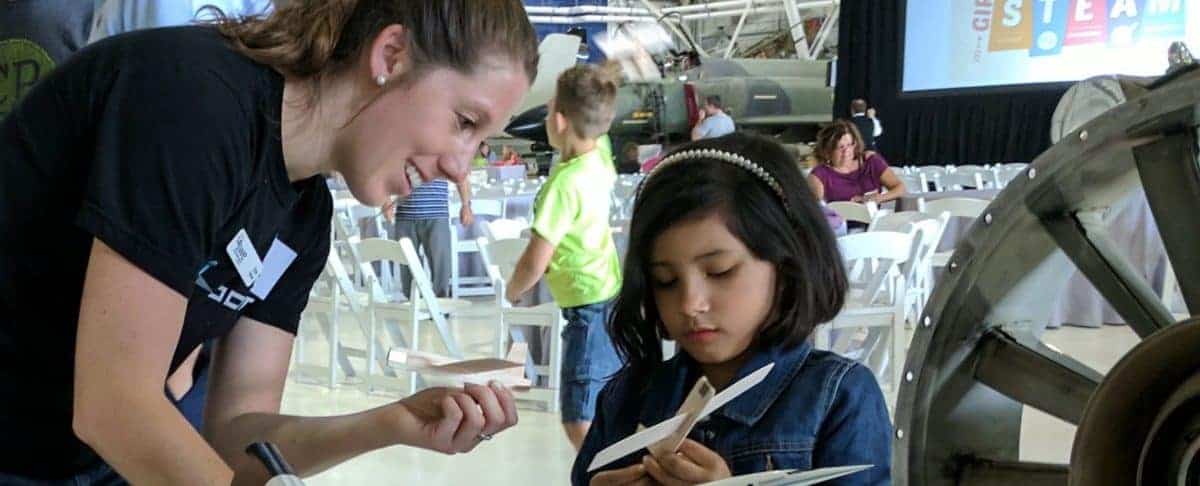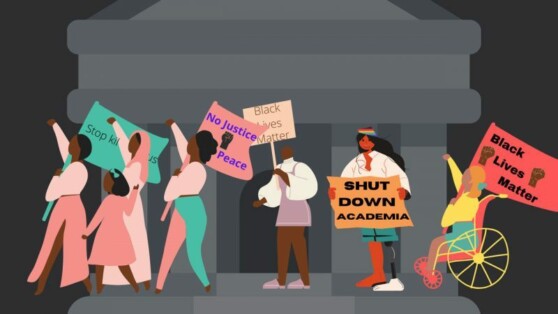How can we get more women in aerospace engineering? Inspire them.
By Erin Fisher
This blog was first posted on Boomsupersonic.com and Medium.
From my desk at work, I can gaze out the window and watch airplanes take off and land all day. Far too often, my male colleagues and I drop what we’re doing and run to the window to see what airplane is in the sky. As we race to catch a glimpse of a rare Stearman or acrobatic F-18, the thought strikes me — I am the only woman in the world building a commercial supersonic airliner. How did I end up here? And more importantly, how can we get more women to stand at this window with me?
When I was 13 years old, I spent a week at Space Camp at the Cosmosphere in Hutchinson, Kansas. This experience altered the course of my life. In middle school, I longed to be a novelist, because it was creative and it seemed glamorous to work at coffee shops and live in a big city. But after a week at Space Camp, all I wanted in life — so badly it hurt — was to be an astronaut. Stories of the Original Seven, simulated missions in the shuttle trainer, the scientific experiments on board each shuttle flight — everything was challenging and exciting and had a sense of importance to it. I was awestruck.
After a week at Space Camp, all I wanted in life — so badly it hurt — was to be an astronaut.
Without this formative Space Camp experience, I never would have pursued engineering or even known that it was a career option. I never worked on a car growing up. I never mowed the lawn or had to fix something broken in the house. I never built furniture for my room. These are the activities that all my male coworkers have in common about their childhood, but somehow, I missed out on them all, and I don’t think that I’m the only woman in this position. This wasn’t due to my parents’ negligence. Neither of them are in STEM fields, so they raised their daughters how they were raised, and an introduction to engineering fields, or even just the dissection of a lawn mower, were not part of that upbringing. I knew so little that I thought if I wanted to be an astronaut, I should study astronomy. It’s an unfortunate truth that we are more likely to direct young boys to play with airplane models or work with tools growing up, than we are to do the same for girls.
Once I discovered aerospace engineering, I pursued it wholeheartedly, applying only to colleges that offered this major. My career drive grew completely out of the experience at Space Camp. The lives and careers of the astronauts I learned about there motivated me. I wanted to be one of the few who expanded the knowledge of the nation by exploring the unknown. I wanted to push technology to its limits as part of an elite team capturing the imagination of generations. These weren’t sentiments I could easily articulate when I was 13, nor can I fully capture the feeling now, but it was a sense of deep excitement to do things very few do, work that could provide so much for our world.
I studied aerospace because of the inspirational magic of the space shuttle program. Likewise, most women with aerospace degrees that I know were inspired by and now work on space-related projects instead of aviation. And for good reason. What has been inspiring in the commercial aviation sector in the past decade? In the past five decades? Commercial airliners have gotten some fancy interior upgrades, or more advanced avionics suites, or different shaped winglets. Nothing truly inspiring has happened in aviation in ages. Even Concorde, which introduced the world to commercial supersonic flight, underwhelmed. It was so expensive to fly that few people could benefit from its supersonic speed. Now it’s a museum piece. With this track record, a lack of interest in or passion for the aviation sector is understandable.
So then how do we get more girls into aviation? We need more inspiration. The industry needs to provide a mission to young women and girls, one that can get them excited to study math and science, to become an engineer, and eventually, to help balance out the gender ratio in the aerospace sector. This is especially important for young women because they are less likely to naturally find that mission in their upbringing. Boom can be that mission.
Boom is not just designing a new airplane. We’re tearing down the barriers to experiencing the planet.
At Boom, we want to change not just the aviation industry, but how the world views travel and distance. We want to bring back commercial supersonic flight not just to save time, but to connect people and places and cultures. Our aircraft shaves days off overseas travel. Imagine what that will do for families when parents can travel for work but still be home in time to tuck their children into bed at night. Imagine the possibility of falling in love across continents, or vacationing in Australia because it’s now as accessible as Hawaii.
Boom is not just designing a new airplane. We’re tearing down the barriers to experiencing the planet. We only want to hire people who want to change the world, so female engineers who are passionate about our mission are perfect hires for us. Our job as a company is to inspire them enough to get them to apply.
Recently, Boom participated in a STEM event at a local aviation museum. This event was targeted towards girls aged 10–17, and provided a diverse range of activities across engineering and science disciplines to introduce girls to potential career or degree fields. We held two workshops focused on the basics of flight and aircraft design by building and testing balsa wood gliders. It’s usually hard to judge what impact our company’s participation in such an event has immediately. But at the end of one of our sessions, three young girls came up to me to tell me that they wanted to be engineers too.
My hope is not only that Boom will soon far outperform the industry in gender balance in engineering, but that we can inspire the next generation of female engineers to pursue a career in aerospace, the same way that Space Camp inspired me, and the Space Shuttle inspired so many others. Somewhere out there is a little girl who will be inspired by the work we do today. I can’t wait to get her resume for an engineering position in 10 or 20 years as we ramp up work on our first Mach 4 airliner.
There is much more to say on this topic — stay tuned for further blog installments. Boom is doubling the size of its engineering team over the next several months. We have openings in aerodynamics, propulsion, software, structures, systems, and manufacturing. If you want to help us tear down the barriers to experiencing the planet, please apply. Female applicants are especially welcome.
I would also love to hear your opinions on how to get more women in aerospace, stop by booth 1457 at WE17, the Society of Women Engineers Annual Conference October 26-28 in Austin, TX.
Thanks to Eli Dourado, Joshua Krall, and Blake Scholl.
Author
-
![Inspire Women to Pursue Aerospace Engineering [] SWE Blog](https://alltogether.swe.org/wp-content/uploads/2021/10/swe-favicon.png)
SWE Blog provides up-to-date information and news about the Society and how our members are making a difference every day. You’ll find stories about SWE members, engineering, technology, and other STEM-related topics.






